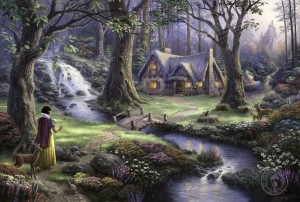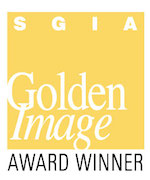The Thomas Kinkade Company’s “Snow White Discovers the Cottage” Serigraph wins the Gold Award at the SGIA Expo International Golden Image competition. More than 66 companies from around the world entered the competition submitting a total of 353 prints in 50 product categories. This years event was one of the most challenging in recent history. Prints are judged on the level of difficulty and quality of execution. Serigraphs are considered to be original art because each one is created individually. Over 80 screens were needed to complete the Snow White Serigraph. The company produced a total of only 550 serigraphs in the 18″x 27″ size. We have number 49 SN in the Gallery…In addition to being a beautiful piece of art, it is also truly collectible because it is the First Serigraph from the Thomas Kinkade Company and it is of the First painting in Thom’s Disney Dreams Collection. For more details on Serigraphs go to our blog at: http://www.thomaskinkadebirmingham.com/blog/
Tag Archives: Serigraph
Thomas Kinkade Serigraph Explained
The Thomas Kinkade Company has just introduced it’s first Serigraph Edition with its introduction of this technology for the initial Disney Dreams Collection painting, “Snow White Discovers the Cottage”
So just what is a Serigraph? In the art world they are considered “originals”, because they are hand crafted one at a time…See below and watch video: http://www.youtube.com/watch?v=6lQnQcsJfHs
What is a Thomas Kinkade Serigraph
From an early age, Thomas Kinkade was fascinated with printmaking and the many different print processes used over history. As a boy, he experimented with silk screening and as an established artist eventually began using silkscreened sketches as remarques on the backs of his paintings. For years
Thom planned to release serigraph editions of his work, now the Thomas Kinkade Company is pleased to be able to fulfill that dream and release the first Thomas Kinkade Serigraph Edition.
Serigraphs are a highly respected print making technique in the art world. Unlike photographic reproductions such as giclée, serigraphs actually involve recreating the original artwork by hand. The
serigrapher prints each individual color of the original, one color at a time, resulting in an exacting hand created reproduction. For each color in the original artwork, a film is cut, screens are exposed, presses are set and pigmented inks are mixed. Each color must be applied layer over layer with lengthy drying periods in-between. No more than two colors can be applied each day, so a 100-color print will take two and a half months from the first screen to the last.
As each color is printed, the registration or alignment of the print to the silkscreen must be in exactly the same place. This is considered the most important part of fine art serigraphy, because each color must be laid down in the exact place needed on the canvas on every print made. In the end, this ancient silk screening process produces a rich, unique, handcrafted serigraph that faithfully reproduces the original with pigmented inks that are unsurpassed in longevity.
Serigraphs will be released in limited quantities as available and in the edition sizes noted on theCertificate of Authenticity.
What is a Serigraph?
• An elite stencil printmaking process, which is different than a photographic giclée process.
• A masterful recreation of the original artwork by hand.
• Highly durable and made with pigmented inks to resistant to fading.
Serigraphy requires diligence and handcraftsmanship for each print and is a very time consuming, multilayered process. The integrity and authenticity of the Serigraph is found in its processes as explained below:
- A stencil or screen is created for each individual color in the original. Typically, 80-90 separate colors will make up one painting; hence 80-90 different screens are used resulting in 80-90 different layers of ink placed in various places on the canvas.
- Once a screen is created, a sheet of high quality, archival canvas or paper is then inserted under the screen and a special pigmented ink is poured along the edge of the frame that holds the screen
- Areas, which do not print, are blocked in each of the stencil screens allowing ink to pass through the screen to specific areas of the painting, while prohibiting it from flowing through to other areas of the canvas.
- A flat fanlike tool is pulled from back-to-front along the screen pushing the ink through, resulting in a direct transfer of the image from screen to the canvas or paper.
- Only one color can be applied at a time.
- The canvas or paper must be fully dry before another color can be added.
- Due to drying times, only 2 colors can be applied in one day.
- This process is repeated layer on top of layer until the entire original print is recreated.
- Complex works of art, with hundreds of colors, can take over 6 weeks or longer to produce.


